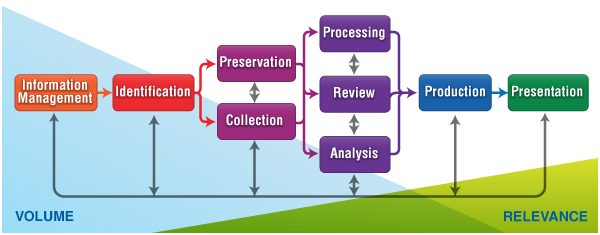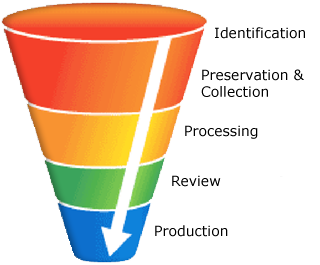SALIX is the regional leader in e-discovery

Electronic discovery or “E-Discovery” refers to the production of relevant, electronically-stored information (ESI) to another party in litigation. With all of the recent technological advances, the ESI world has grown exponentially. Consider that:
The tremendous amount of electronic data has resulted in a number of new challenges in the legal industry. In this day and age, it is crucial that lawyers and legal professionals have a working knowledge of legal technology and data preservation retention policies. Without such knowledge, it is impossible to navigate the ever-expanding world of ESI.
By its very nature, ESI poses a number of unique issues for litigants. In years past, information was stored in boxes, filing cabinets and warehouses. In the new world of ESI, information can be found in a multitude of locations. Computers, e-mails, CDs, DVDs, cell phones, PDAs, and flash drives are just a few of the places where electronic files reside. Additionally, there are many new challenges involving electronic information. With a few clicks of a button, electronic information can be altered or even deleted altogether. And at a time when mobile phone casinos are becoming more and more popular, the problem of storing and processing information has become the most urgent.
In 2006, Federal Rules of Civil Procedure were amended to include procedures for handling e-discovery and issues associated with it. Rather than simplifying things, the new rules have only further complicated the e-discovery process. The types of evidence that constitute ESI have expanded considerably. Additionally, strict deadlines have been put in place with regards to production of the evidence as well as regulations involving early meet-and-confer sessions. Serious penalties, including court sanctions, were also laid out for parties who do not adhere to these new rules.
With the challenging and risky nature of ESI, it is important that you choose a partner who has the expertise and experience to streamline the process of producing defensible results, while at the same time, reducing your burden and cost. SALIX is the regional leader in e-discovery and the right partner to help you succeed in your next case. With almost 20 years of experience and certified computer forensic experts, SALIX has the experience and expertise to help your organization implement the best practices for ESI.
The key components when dealing with ESI are as follows:

With so much data, one of the biggest challenges can be determining where to start. SALIX’s certified experts will help you investigate and map all sources of electronic information available. We can determine the location of all the data you or your client may have a duty to preserve and potentially disclose in a pending or prospective legal proceeding.
Together we can determine the likely custodians of relevant data, where and how that data is stored, and the differences between actual practices and written procedures at relevant institutions. It is important to identify the correct starting point to ensure that you will retrieve all of the pertinent data as required by law.
After identifying what data is to be targeted for collection, it is important to preserve that data in a legally-defensible way. SALIX’s certified experts are able to execute preservation strategies that meet all stringent legal requirements. We will work with you during the meet-and-confer process to advise you on methods and techniques of preservation. In addition, SALIX will assist you throughout the legal hold process. Our involvement ensures legally-defensible preservation as well as adding efficiencies and cost savings.
Managing, organizing and collecting large volumes of data from multiple sources in various locations can be especially burdensome and it requires skill and experience to be done in an effective and legally-defensible manner. It is important that all collections are completed in a comprehensive way, maintaining the integrity of the content and preserving its form. Proper collection of data is important to ensure accurate, efficient, and cost-effective responses to any e-discovery request.
SALIX employs the most up-to-date technologies when it comes to the collection and processing of ESI. Our qualified team of experts is fully certified and any data that they discover is legally defensible. A strict chain of custody is always maintained and our extensive use of computer forensics, such as archival media restoration, data recovery, and forensic hard drive imaging, ensures that all pertinent data is uncovered. If the information is anywhere to be found, we will find it.
Even with the most targeted of e-discovery processes, the collection step produces large quantities of data. Often, upwards of 90% of this data is non-responsive. SALIX takes a two-step approach to removing the unwanted and unneeded data to get to the pertinent information.
The first step is to cull the data. In this step we remove all content that is irrelevant. This would include removing duplications of original documents or emails and elimination of known system file types as determined by the National Institute of Standards and Technologies.
The second step indentifies which content is most likely relevant and will require actual review. We can accomplish this according to the parameters determined and negotiated in the meet-and-confer session. Specifications can include key-word searching and custodian lists as well as delimiters such as timeframe, date range and file types.

Even after the processing and culling of the data, there can still be large quantities of information to be reviewed by counsel. The review process can be overwhelming without the proper partner to help manage the process.
SALIX is committed to enhancing the effectiveness and efficiency of the review process while, at the same time, eliminating unnecessary costs. By utilizing technology such as online review tools and data conversion software, you are able to review the data in its native format or convert all documents to a TIFF or PDF files.
In addition, SALIX offers analytic tools that help you pare down review sets, find key documents, identify confidential or privileged documents, remove spam and analyze large document populations. These tools can:
The final step in the e-discovery process is production. Once you have decided what is ultimately relevant to the case, we can produce those files in whatever form or forms are requested, whether they are paper or electronic, native or in TIFF or PDF format.
We hold certifications in Summation and Case Logistix as well as a number of other electronic review tools. As a result, we can provide you with the necessary load files for these programs. We also maintain fully-encrypted and password-protected FTP sites and electronic repositories where you can access your documents online if you so choose.